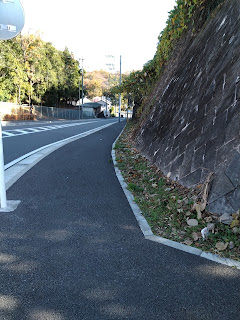The deadline for making specimens for 2022 Water Source Monitoring is approaching rapidly (; my post on October 21). So, I invited my senior Forest Instructors to Yadoriki Water Source Forest やどりき水源林 to make the one for December 2022.
 |
| The sun was warm on that day … |
When we do this as activities of Forest Instructor, we do not make specimens when we catch creatures in Yadoriki. We study them in vats for a while, take pictures, and return them to the stream. I asked the Environmental Research Center if it is OK to do the same for Water Source Monitoring. The answer was “No.” They say the Office studies the changes in rivers over the years by the current and previous specimens. For that, making a photo or two to one catch would not be enough. OK. Moreover, Forest Instructors do such water activity usually in the middle of summer. Enjoying chilly Yadoriki’s water when it is 35°C in Yokohama is heavenly … But during winter, we have not done the study of aquatic lives. It must be damned cold, we thought. Sure enough, when we entered the Water Source Forest that Sunday, the peaks of mountains surrounding Yadoriki Forest were snow-capped. The air temperature was 7°C at the admin hut of the Forest. I a sort of braced myself for freezing water and entered Yadoriki Stream.
To our surprise, it was not that cold. The water had 10°C where we collected the specimen. The stream had lots of debris of fallen autumn leaves + algae. It was very different from Yadoriki Stream in summer when it does not have much fallen something. One of my seniors said “Wow, I’ve never noticed this much algae in Yadoriki Stream!” I don’t know how to identify these vegetables. I hope they are not invasive one ... In summer, we simply turn rocks in water, brush the bottom to collect bugs in landing nets. This time, we dunk our nets in the gathered fallen leaves and algae. Then, voilá! There were far more creatures we could catch compared with our standard activity during summer. In less than 10 minutes, we had to stop our collection in order to finish making specimen before lunch. “I see. During winter, the predator fish slow their activity a lot. That makes life in water easy.” “Yeah, and trees shed their leaves. Enough sunlight reaches the river. Algae can thrive. They become food for aquatic creatures.” “The same function for fallen leaves. Aquatic bugs can eat them and make a warm dwelling in the pile of fallen leaves, I think.” So, there are far more living things in water! We were excited during our hunt.
 |
| Lots of baby food and construction materials in water |
 |
| The
same point as the above photo in September this year. No debris, you see? |
 |
| Inevitably, the vat became full of leaves and algae. |
In less than one hour, a jar had lots of lots of specimen. When we studied the contents of the vat, the majority of the creatures are tiny baby insects. They hatched this fall and now spend their early days in winter water, eating baby foods of algae and fallen leaves. Some of them would survive and become bigger creatures in spring and summer next year. “So, Naomi, you’ll identify them under stereo microscope.” “That’ll be a tons of job!” Phew. The deadline for identification is January 27th …
 |
| Here
is the specimen. I have to work with it next month … |
If you find environmental issues in waters of Kanagawa Prefecture, please make a contact with Kanagawa Environmental Research Center 神奈川県環境科学センター
1-3-39 Shinomiya, Hiratsuka City, 254-0014
〒254-0014平塚市四之宮1-3-39
Phone: 0463-24-3311
FAX: 0463-24-3300
k-center@k-erc.pref.kanagawa.jp

























































